| Principal
Investigators |
George
R. Sedberry, Ph.D.
Senior Marine Scientist
South Carolina Department of Natural Resources
 George Sedberry is the Principal Investigator on the Ocean Exploration
2003 Expedition to the Charleston Bump. He spent his formative years
on the Chesapeake Bay in Virginia, where he completed a B.S. degree
in Biology at Old Dominion University, and the M.S. and Ph.D. degrees
in Marine Science at the Virginia Institute of Marine Science, College
of William and Mary. He is a Senior Marine Scientist at the Marine Resources
Research Institute, South Carolina Department of Natural Resources.
He is Assistant Director of MRRI where he has worked since 1980. His
interests and experience are in the biology, conservation and management
of reef fishes and highly migratory oceanic fishes, as well as deep-sea
biology and coral-reef
George Sedberry is the Principal Investigator on the Ocean Exploration
2003 Expedition to the Charleston Bump. He spent his formative years
on the Chesapeake Bay in Virginia, where he completed a B.S. degree
in Biology at Old Dominion University, and the M.S. and Ph.D. degrees
in Marine Science at the Virginia Institute of Marine Science, College
of William and Mary. He is a Senior Marine Scientist at the Marine Resources
Research Institute, South Carolina Department of Natural Resources.
He is Assistant Director of MRRI where he has worked since 1980. His
interests and experience are in the biology, conservation and management
of reef fishes and highly migratory oceanic fishes, as well as deep-sea
biology and coral-reef 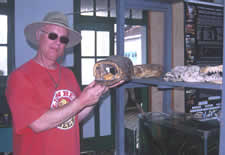 ecology.
Most of his research is concentrated on hard bottom reefs of subtropical
and temperate waters off the southeastern U.S., but he has conducted
research on Marine Protected Areas in Belize and on population biology
of fishes from the North and South Atlantic, Caribbean Sea, Mediterranean
Sea and the western South Pacific. He serves on the Marine Protected
Areas Advisory Panel and the Snapper/Grouper Assessment Panel of the
South Atlantic Fishery Management Council; is Vice Chairman of the Gray’s
Reef National Marine Sanctuary Advisory Council; and is on the boards
of the Southeast Center for Ocean Science Education Excellence and the
South Carolina Marine Educators Association. He is also an Adjunct Professor
at the College of Charleston, where he advises graduate students and
teaches marine fisheries science. He is a member of the American Fisheries
Society, the American Society of Ichthyologists and Herpetologists and
a fellow of the American Institute of Fishery Research Biologists. He
has authored over 70 scientific publications on marine fishes and ecosystems. ecology.
Most of his research is concentrated on hard bottom reefs of subtropical
and temperate waters off the southeastern U.S., but he has conducted
research on Marine Protected Areas in Belize and on population biology
of fishes from the North and South Atlantic, Caribbean Sea, Mediterranean
Sea and the western South Pacific. He serves on the Marine Protected
Areas Advisory Panel and the Snapper/Grouper Assessment Panel of the
South Atlantic Fishery Management Council; is Vice Chairman of the Gray’s
Reef National Marine Sanctuary Advisory Council; and is on the boards
of the Southeast Center for Ocean Science Education Excellence and the
South Carolina Marine Educators Association. He is also an Adjunct Professor
at the College of Charleston, where he advises graduate students and
teaches marine fisheries science. He is a member of the American Fisheries
Society, the American Society of Ichthyologists and Herpetologists and
a fellow of the American Institute of Fishery Research Biologists. He
has authored over 70 scientific publications on marine fishes and ecosystems. |
Stephen
E. Stancyk, Ph.D.
Professor
University of South Carolina  Dr.
Stephen Stancyk has been a professor of Marine Science and Biological
Sciences at the University of South Carolina since 1975. Steve grew
up in Colorado, and received his B.A. from the University of Colorado.
He was awarded the M.S. and Ph.D. in Zoology from the University of
Florida. Steve teaches courses in Marine Biology, Invertebrate Zoology
and Reproductive Ecology. He has studied a wide range of Dr.
Stephen Stancyk has been a professor of Marine Science and Biological
Sciences at the University of South Carolina since 1975. Steve grew
up in Colorado, and received his B.A. from the University of Colorado.
He was awarded the M.S. and Ph.D. in Zoology from the University of
Florida. Steve teaches courses in Marine Biology, Invertebrate Zoology
and Reproductive Ecology. He has studied a wide range of 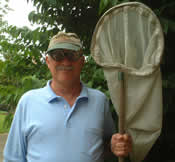 organisms
from sea turtles to copepods, and his current research centers around
life histories and reproduction of ophiuroid echinoderms (brittlestars).
He is particularly interested in how brittlestars have modified growth
and reproductive patterns to adapt to frequent arm loss. Steve has
been a P.I. on a previous manned submersible project and has performed
research in a variety of marine habitats in Bermuda, the Caribbean,
Central America, Ecuador and the Galapagos, Brazil, New Zealand and
Papua New Guinea. He enjoys fishing, boating, hiking, birdwatching
and SCUBA. organisms
from sea turtles to copepods, and his current research centers around
life histories and reproduction of ophiuroid echinoderms (brittlestars).
He is particularly interested in how brittlestars have modified growth
and reproductive patterns to adapt to frequent arm loss. Steve has
been a P.I. on a previous manned submersible project and has performed
research in a variety of marine habitats in Bermuda, the Caribbean,
Central America, Ecuador and the Galapagos, Brazil, New Zealand and
Papua New Guinea. He enjoys fishing, boating, hiking, birdwatching
and SCUBA.
|
Charles
A. Barans, Ph.D.
Senior Marine Scientist
Marine Resources Research Institute,
South Carolina Department of Natural Resources
 Charlie
Barans entered this world a long time ago, grew up in the Midwest
“corn belt” and experienced a brief post-high school stay
onboard an aircraft carrier. Fortunately, he was guided away from
Forestry as a career early at Ohio State University, where he talked
them out of a BS degree. His interest in fish populations and communities
intensified through further educational experiences (and more fast
talking) at VIMS, for a MA in Marine Fisheries, and back to OSU, for
a PhD. An early exposure to the excitement of environmental consulting
outside of NY City and drinking Maalox from the bottle before and
after staff meetings convinced him to pursue marine fisheries with
SCDNR. He and his sparkling wife, Allene, have two wonderful daughters
and, presently, are enjoying being “empty nesters.” For
over 23 years, he assisted in guiding a dynamic team that developed
fishery independent research and assessments for the NMFS’ largest
continuous contract (MARMAP) in the southeast. The resulting long-term
databases were created with standardized techniques for detection
of future changes in species relative abundances and fish assemblages
in several important habitats. Also, production scale processing of
life history materials was established, and several assessment techniques,
including routine use of underwater video were developed. Charlie
has always believed that seemingly impossible fisheries research could
be completed through team efforts and that positive attitudes among
coworkers could be encouraged through camaraderie, encouragement and
matching personal skills and interests with a program’s direction.
He likes to promote laughter as a step toward group mental health.
Presently continuing his long quest for a rapid and remote fishery
assessment technique, he has focused on the application of multi-frequency
acoustics to studying plankton transport through inlets. Strong belief
in collaborative approaches and a wealth of great coworkers have assisted
in the formation of interdisciplinary teams including the opportunity
to help develop an expanding mentor based project to train minorities
in marine and environmental science. Recent crusades include the establishment
of marine fisheries reserves as ecosystem management tools and coaxing
an underwater TV to send daily images from a reef fish assemblage
at mid-shelf to a web site. He can’t believe that people actually
read these sketches! Charlie
Barans entered this world a long time ago, grew up in the Midwest
“corn belt” and experienced a brief post-high school stay
onboard an aircraft carrier. Fortunately, he was guided away from
Forestry as a career early at Ohio State University, where he talked
them out of a BS degree. His interest in fish populations and communities
intensified through further educational experiences (and more fast
talking) at VIMS, for a MA in Marine Fisheries, and back to OSU, for
a PhD. An early exposure to the excitement of environmental consulting
outside of NY City and drinking Maalox from the bottle before and
after staff meetings convinced him to pursue marine fisheries with
SCDNR. He and his sparkling wife, Allene, have two wonderful daughters
and, presently, are enjoying being “empty nesters.” For
over 23 years, he assisted in guiding a dynamic team that developed
fishery independent research and assessments for the NMFS’ largest
continuous contract (MARMAP) in the southeast. The resulting long-term
databases were created with standardized techniques for detection
of future changes in species relative abundances and fish assemblages
in several important habitats. Also, production scale processing of
life history materials was established, and several assessment techniques,
including routine use of underwater video were developed. Charlie
has always believed that seemingly impossible fisheries research could
be completed through team efforts and that positive attitudes among
coworkers could be encouraged through camaraderie, encouragement and
matching personal skills and interests with a program’s direction.
He likes to promote laughter as a step toward group mental health.
Presently continuing his long quest for a rapid and remote fishery
assessment technique, he has focused on the application of multi-frequency
acoustics to studying plankton transport through inlets. Strong belief
in collaborative approaches and a wealth of great coworkers have assisted
in the formation of interdisciplinary teams including the opportunity
to help develop an expanding mentor based project to train minorities
in marine and environmental science. Recent crusades include the establishment
of marine fisheries reserves as ecosystem management tools and coaxing
an underwater TV to send daily images from a reef fish assemblage
at mid-shelf to a web site. He can’t believe that people actually
read these sketches!
|
Dr.
Brian Helmuth, PhD
Assistant Professor
Department of Biological Sciences and
Marine Sciences program, University of
South Carolina
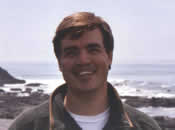 Dr. Helmuth is a marine physiological ecologist with a focus on benthic
invertebrates. He and his students use engineering methods (biophysics
and biomechanics) to study the ways in which animals interact with their
environment. Much of his most recent research has centered on the effects
Dr. Helmuth is a marine physiological ecologist with a focus on benthic
invertebrates. He and his students use engineering methods (biophysics
and biomechanics) to study the ways in which animals interact with their
environment. Much of his most recent research has centered on the effects
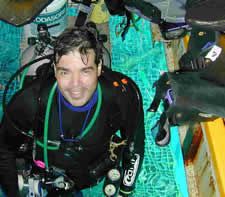 of
climate change on intertidal animals in the eastern Pacific, and he
and his colleagues have developed methods for predicting the temperatures
of animals from climatic data. Dr. Helmuth also has extensive experience
working on coral reefs, and he has active projects in Belize and Florida,
including several saturation missions in the Aquarius habitat. Dr. Helmuth
is a principal investigator for the Invertebrate Diversity project on
this cruise, and will work with other team members to link aspects of
small-scale water flow to patterns in invertebrate diversity. He also
has a deep interest in developing collaborations between higher education
faculty and K-12 students and teachers, and is an active member of the
South Carolina Marine Educator’s Association. which can be found
at http://www.coastal.edu/science/scmea/ of
climate change on intertidal animals in the eastern Pacific, and he
and his colleagues have developed methods for predicting the temperatures
of animals from climatic data. Dr. Helmuth also has extensive experience
working on coral reefs, and he has active projects in Belize and Florida,
including several saturation missions in the Aquarius habitat. Dr. Helmuth
is a principal investigator for the Invertebrate Diversity project on
this cruise, and will work with other team members to link aspects of
small-scale water flow to patterns in invertebrate diversity. He also
has a deep interest in developing collaborations between higher education
faculty and K-12 students and teachers, and is an active member of the
South Carolina Marine Educator’s Association. which can be found
at http://www.coastal.edu/science/scmea/
For more information on the Helmuth Lab, please visit their web site
at http://www.biol.sc.edu/~helmuthlab |
Leslie
R. Sautter, Ph.D.
Associate Professor
Project Oceanica, Dept. of Geology and Environmental Geosciences,
College of Charleston
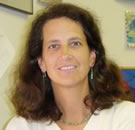 Leslie
Sautter received her Ph.D. in geological sciences at the University
of South Carolina in 1990. Her recent research focuses on the distribution
and ecology of Leslie
Sautter received her Ph.D. in geological sciences at the University
of South Carolina in 1990. Her recent research focuses on the distribution
and ecology of 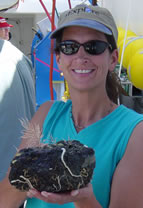 benthic
foraminifera within surface sediments of the South Atlantic Bight.
She is also examining the rocky outcrops exposed on the deep reef
habitats of the shelf edge and Charleston Bump. Leslie became a geology
department faculty member at the College of Charleston, SC in 1992,
and teaches classes in marine and coastal geology and general marine
science to undergraduates, graduate students and K-12 teachers. Her
activities are devoted to promoting undergraduate research, and her
involvement with developing new methods of teaching marine science
to college students and teachers earned her the 2002 National Marine
Education Award. With NOAA NOS funding, Sautter recently established
Project Oceanica at the College of Charleston, which serves to bring
scientific results to a broad audience of users – focusing on
college students – through development of web-based research-oriented
educational resource products. Leslie participated in both the Islands
in the Stream 2001 and 2002 expeditions and will serve again as a
shipboard geologist and science education liaison for the Charleston
Bump 2003 expedition. benthic
foraminifera within surface sediments of the South Atlantic Bight.
She is also examining the rocky outcrops exposed on the deep reef
habitats of the shelf edge and Charleston Bump. Leslie became a geology
department faculty member at the College of Charleston, SC in 1992,
and teaches classes in marine and coastal geology and general marine
science to undergraduates, graduate students and K-12 teachers. Her
activities are devoted to promoting undergraduate research, and her
involvement with developing new methods of teaching marine science
to college students and teachers earned her the 2002 National Marine
Education Award. With NOAA NOS funding, Sautter recently established
Project Oceanica at the College of Charleston, which serves to bring
scientific results to a broad audience of users – focusing on
college students – through development of web-based research-oriented
educational resource products. Leslie participated in both the Islands
in the Stream 2001 and 2002 expeditions and will serve again as a
shipboard geologist and science education liaison for the Charleston
Bump 2003 expedition.
|
Richard
Styles, Ph.D.
Assistant Professor
Marine Science Program &
Department of Geological Sciences
University of South Carolina
 Richard Styles grew up in Tennessee – an unlikely beginning
for an oceanographer. After switching universities several times and
a 3-year stint in the U.S. Army, Richard received a B.S. degree in
Physics from the University of Tennessee. He then moved south to obtain
an M.S. degree in Physical Oceanography from the Florida Institute
of Technology. From there, he traveled north to obtain his Ph.D. degree
in Oceanography from Rutgers University in New Jersey. After graduating
in 1998, Richard remained at Rutgers as a post-doctoral researcher
and then as a research scientist. Richard joined the University of
South Carolina in December of 2002 as an Assistant Professor in the
Department of Geological Sciences. His primary research interests
include coastal processes and bottom boundary layer dynamics. He conducts
research on the turbulent flow very near the seabed and develops mathematical
models to describe this flow. In particular, he is interested in understanding
how near-bed currents mix the water column and supply nutrients and
food to bottom-dwelling organisms. Richard also conducts studies of
sediment transport in the context of water quality and pollutant dispersal.
His research has carried him from the murky cold waters of New Jersey
to the warm inland estuaries of South Carolina.
Richard Styles grew up in Tennessee – an unlikely beginning
for an oceanographer. After switching universities several times and
a 3-year stint in the U.S. Army, Richard received a B.S. degree in
Physics from the University of Tennessee. He then moved south to obtain
an M.S. degree in Physical Oceanography from the Florida Institute
of Technology. From there, he traveled north to obtain his Ph.D. degree
in Oceanography from Rutgers University in New Jersey. After graduating
in 1998, Richard remained at Rutgers as a post-doctoral researcher
and then as a research scientist. Richard joined the University of
South Carolina in December of 2002 as an Assistant Professor in the
Department of Geological Sciences. His primary research interests
include coastal processes and bottom boundary layer dynamics. He conducts
research on the turbulent flow very near the seabed and develops mathematical
models to describe this flow. In particular, he is interested in understanding
how near-bed currents mix the water column and supply nutrients and
food to bottom-dwelling organisms. Richard also conducts studies of
sediment transport in the context of water quality and pollutant dispersal.
His research has carried him from the murky cold waters of New Jersey
to the warm inland estuaries of South Carolina.
|
Elizabeth
L. Wenner, PhD.
Research Marine Scientist
Marine Resources Center
South Carolina Department of Natural Resources
 Dr.
Wenner grew up on Chesapeake Bay where she developed an early love for
the sea and its inhabitants. After receiving a BS degree in Biology
from Mary Washington College, she attended graduate school at the Virginia
Institute of Marine Science of the College of William and Mary where
she received MS and Ph.D. degrees in Marine Science. Her dissertation
research described communities of decapod crustaceans along a depth
gradient from the upper to lower continental slope in the Norfolk Canyon.
She has worked for the last twenty-two years as a research marine scientist
and program manager for Crustacean and Wetlands Research at the Marine
Resources Center of the South Carolina Department of Natural Resources,
located in Charleston, SC. During her tenure at the Marine Resources
Center, she has studied invertebrate communities in a variety of habitats
from estuaries to the deepsea. Her special interest is the decapod crustaceans
or crabs and shrimps. Dr. Wenner also heads up the Southeastern Regional
Taxonomic Center, housed within SCDNR’s Marine Resources Research
Institute (MRRI). The SERTC provides a regional focus on developing
taxonomic expertise and skills, as well as the infrastructure needed
to support the natural resource management and scientific communities
within the South Atlantic Bight. The Center is staffed by SCDNR employees
with a background in taxonomy and serves as a clearinghouse, training
facility, specimen repository, and a venue for a Dr.
Wenner grew up on Chesapeake Bay where she developed an early love for
the sea and its inhabitants. After receiving a BS degree in Biology
from Mary Washington College, she attended graduate school at the Virginia
Institute of Marine Science of the College of William and Mary where
she received MS and Ph.D. degrees in Marine Science. Her dissertation
research described communities of decapod crustaceans along a depth
gradient from the upper to lower continental slope in the Norfolk Canyon.
She has worked for the last twenty-two years as a research marine scientist
and program manager for Crustacean and Wetlands Research at the Marine
Resources Center of the South Carolina Department of Natural Resources,
located in Charleston, SC. During her tenure at the Marine Resources
Center, she has studied invertebrate communities in a variety of habitats
from estuaries to the deepsea. Her special interest is the decapod crustaceans
or crabs and shrimps. Dr. Wenner also heads up the Southeastern Regional
Taxonomic Center, housed within SCDNR’s Marine Resources Research
Institute (MRRI). The SERTC provides a regional focus on developing
taxonomic expertise and skills, as well as the infrastructure needed
to support the natural resource management and scientific communities
within the South Atlantic Bight. The Center is staffed by SCDNR employees
with a background in taxonomy and serves as a clearinghouse, training
facility, specimen repository, and a venue for a 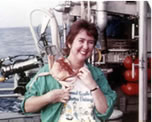 taxonomic
library. Dr. Wenner works on numerous other projects at MRRI, and is
principal investigator for the SEAMAP Shallow Water Trawl Program, serves
as Research Coordinator for the ACE Basin National Estuarine Research
Reserve (NERR), and supervises the state’s crustacean monitoring
program for blue crab and commercially important shrimp. She has been
elected to numerous offices, including President of The Crustacean Society,
an international scientific organization. Over the years, she has been
appointed to serve on several national advisory and technical committees,
including an appointment by the Secretary of Commerce to the Marine
Fisheries Advisory Committee of the National Marine Fisheries Service.
She has written over 80 scientific publications and in her spare time,
enjoys showing her Labrador retrievers, running, gardening and antique
collecting. She and her husband, Dr. Charles Wenner, live on beautiful
Wadmalaw Island, a rural sea island located south of Charleston. taxonomic
library. Dr. Wenner works on numerous other projects at MRRI, and is
principal investigator for the SEAMAP Shallow Water Trawl Program, serves
as Research Coordinator for the ACE Basin National Estuarine Research
Reserve (NERR), and supervises the state’s crustacean monitoring
program for blue crab and commercially important shrimp. She has been
elected to numerous offices, including President of The Crustacean Society,
an international scientific organization. Over the years, she has been
appointed to serve on several national advisory and technical committees,
including an appointment by the Secretary of Commerce to the Marine
Fisheries Advisory Committee of the National Marine Fisheries Service.
She has written over 80 scientific publications and in her spare time,
enjoys showing her Labrador retrievers, running, gardening and antique
collecting. She and her husband, Dr. Charles Wenner, live on beautiful
Wadmalaw Island, a rural sea island located south of Charleston. |
John
McDonough
Special Projects Office, NOAA
 John
McDonough received his Master’s degree in environmental science
and policy from the Johns Hopkins University in Washington, DC in
1998, and a B.S. in coastal geomorphology from the University of Maryland
in 1989. He has been a physical scientist with NOAA’s National
Ocean Service since 1989, where he developed data and geographic information
systems related to coastal and marine environments, and applied that
information to help prepare management plans for marine protected
areas. Most recently, Mr. McDonough has been serving as the project
manager for large-scale undersea research expeditions using a variety
of tools and techniques including manned and unmanned submersibles.
Specific efforts include the Sustainable Seas Expeditions, a joint
endeavor between NOAA and the National Geographic Society to explore
the system of National Marine Sanctuaries managed by NOAA’s
National Ocean Service. He is committed to exploring and learning
more about natural systems in marine and coastal areas, providing
the data and information required for effective ecosystem-based management. John
McDonough received his Master’s degree in environmental science
and policy from the Johns Hopkins University in Washington, DC in
1998, and a B.S. in coastal geomorphology from the University of Maryland
in 1989. He has been a physical scientist with NOAA’s National
Ocean Service since 1989, where he developed data and geographic information
systems related to coastal and marine environments, and applied that
information to help prepare management plans for marine protected
areas. Most recently, Mr. McDonough has been serving as the project
manager for large-scale undersea research expeditions using a variety
of tools and techniques including manned and unmanned submersibles.
Specific efforts include the Sustainable Seas Expeditions, a joint
endeavor between NOAA and the National Geographic Society to explore
the system of National Marine Sanctuaries managed by NOAA’s
National Ocean Service. He is committed to exploring and learning
more about natural systems in marine and coastal areas, providing
the data and information required for effective ecosystem-based management.
|
Jeremy
Potter
NOAA Office of Exploration
 Jeremy
Potter grew up in wild wonderful West Virginia and graduated from Davidson
College in North Carolina. Immediately after college, he became nervous
about beginning law school and ran off to Alaska to work as an observer
in the Bering Sea crab fishery, and later as an instructor at the Wallops
Island Marine Science Consortium. In 1997, he again ran from graduate
school to spend one year teaching English in rural Japan. Three years
later, he returned to the US to pursue his interests in international
environmental politics, facilitation, and negotiation. Mr. Potter is
a master’s student at the Duke University School of the Environment.
His current research in international fisheries policy focuses on the
Japanese pelagic longline industry. His fascination with the deep sea
led him to NOAA’s Office of Ocean Exploration (OE) where he is
a Dean John A. Knauss Marine Policy Sea Grant Fellow. In the office,
he spends most of his time integrating the operations and science programs. Jeremy
Potter grew up in wild wonderful West Virginia and graduated from Davidson
College in North Carolina. Immediately after college, he became nervous
about beginning law school and ran off to Alaska to work as an observer
in the Bering Sea crab fishery, and later as an instructor at the Wallops
Island Marine Science Consortium. In 1997, he again ran from graduate
school to spend one year teaching English in rural Japan. Three years
later, he returned to the US to pursue his interests in international
environmental politics, facilitation, and negotiation. Mr. Potter is
a master’s student at the Duke University School of the Environment.
His current research in international fisheries policy focuses on the
Japanese pelagic longline industry. His fascination with the deep sea
led him to NOAA’s Office of Ocean Exploration (OE) where he is
a Dean John A. Knauss Marine Policy Sea Grant Fellow. In the office,
he spends most of his time integrating the operations and science programs. |
| Participating
Scientists |
Fred
Andrus, Ph.D.
Geologist
Savannah River Ecology Laboratory
University of Georgia 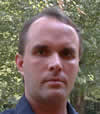 Fred
Andrus was born and raised in Charleston, South Carolina. He received
his BA and MA degrees in Anthropology with a focus in archaeology
from the University of Georgia. He then expanded his education to
include Geology, in which he earned his Fred
Andrus was born and raised in Charleston, South Carolina. He received
his BA and MA degrees in Anthropology with a focus in archaeology
from the University of Georgia. He then expanded his education to
include Geology, in which he earned his 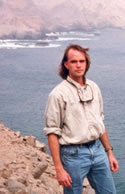 Ph.D.
His research often focuses on the relationship between past climate,
ecology, and human activity. For example, a recent project involved
assessing changes in Pacific Ocean temperatures and fish populations
through stable oxygen isotope analysis of fish otoliths excavated
from archaeological sites on the coast of Peru. The goal of this research
was to better define the Holocene history of El Niño and determine
the ways in which it affected local human populations through time.
Other projects also focus on the paleoclimatic and paleoecological
records preserved in the geochemistry of marine oraganisms, such as
mollusks and corals, and what these records tell us about past climate
and human-environment interaction. Dr. Andrus will be collecting deep
water corals on this cruise in order to help determine their growth
rates, incremental periodicity, and utility as paleoclimate proxies
by employing elemental, stable isotope and radioisotope chemistry. Ph.D.
His research often focuses on the relationship between past climate,
ecology, and human activity. For example, a recent project involved
assessing changes in Pacific Ocean temperatures and fish populations
through stable oxygen isotope analysis of fish otoliths excavated
from archaeological sites on the coast of Peru. The goal of this research
was to better define the Holocene history of El Niño and determine
the ways in which it affected local human populations through time.
Other projects also focus on the paleoclimatic and paleoecological
records preserved in the geochemistry of marine oraganisms, such as
mollusks and corals, and what these records tell us about past climate
and human-environment interaction. Dr. Andrus will be collecting deep
water corals on this cruise in order to help determine their growth
rates, incremental periodicity, and utility as paleoclimate proxies
by employing elemental, stable isotope and radioisotope chemistry.
|
Dewey
Golub
Technology Specialist & Webmaster
Project Oceanica
College of Charleston
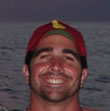 A
love of the Ocean is what brought Dewey to where heam today. Dewey received
A B.S. in Marine Biology from The College of Charleston in South Carolina
in 1998. Dewey moved to Palm Beach Florida after graduation, scuba diving
constantly working as a Dive A
love of the Ocean is what brought Dewey to where heam today. Dewey received
A B.S. in Marine Biology from The College of Charleston in South Carolina
in 1998. Dewey moved to Palm Beach Florida after graduation, scuba diving
constantly working as a Dive 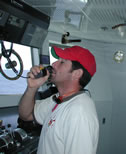 Master
aboard a few of the locally operated dive boats here he learned first
hand reef habitats and their species interactions. Dewey also worked
at the Marinelife Center of Juno Beach working as a Sea Turtle Biologist.
The center was a Turtle rehabilitation clinic as well as conducting
nesting surveys on five miles of very heavily nested beach. In the years
after Florida Dewey spent time with a internet start-up in Boston learning
technologies. The lure of the ocean called again and Dewey went to sea
as a deckhand on 300+ ton motor yachts. Not much science, but the chance
to sea many diverse ocean habitats from the large, cold water species
of the Pacific NorthWest to the over fished Mediterranean. When he was
recently offered the chance to return to the College of Charleston and
marine sciences he jumped at it. Now Dewey works up the education outreach
websites that accompany Scientific exploration and research in the SouthEast
region. During the Charleston Bump mission Dewey will be build up the
website you are now on, create educational resources and compile photo
and video galleries. Master
aboard a few of the locally operated dive boats here he learned first
hand reef habitats and their species interactions. Dewey also worked
at the Marinelife Center of Juno Beach working as a Sea Turtle Biologist.
The center was a Turtle rehabilitation clinic as well as conducting
nesting surveys on five miles of very heavily nested beach. In the years
after Florida Dewey spent time with a internet start-up in Boston learning
technologies. The lure of the ocean called again and Dewey went to sea
as a deckhand on 300+ ton motor yachts. Not much science, but the chance
to sea many diverse ocean habitats from the large, cold water species
of the Pacific NorthWest to the over fished Mediterranean. When he was
recently offered the chance to return to the College of Charleston and
marine sciences he jumped at it. Now Dewey works up the education outreach
websites that accompany Scientific exploration and research in the SouthEast
region. During the Charleston Bump mission Dewey will be build up the
website you are now on, create educational resources and compile photo
and video galleries. |
Linda Harrell
Educator-at-Sea |
Frank
Helies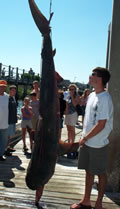
Marine Biology Research Technician
Fish Ecology Laboratory
University of South Carolina
 Frank
Helies was born and raised at the New Jersey shore, and received a
BS in Marine Science from the University of South Carolina in 2002.
He has research experience in zooplanktivory by marine invertebrates,
particularly brittlestars, light trap modification for the capture
of larval freshwater and saltwater fish, and fish otolith increment
analysis. His research interests include the age, growth, life history
and predation patterns of saltwater fish. He is currently working
on the age and growth of larval and juvenile freshwater fish from
the Savannah River Site with respect to anthropogenically impacted
streams. Frank
Helies was born and raised at the New Jersey shore, and received a
BS in Marine Science from the University of South Carolina in 2002.
He has research experience in zooplanktivory by marine invertebrates,
particularly brittlestars, light trap modification for the capture
of larval freshwater and saltwater fish, and fish otolith increment
analysis. His research interests include the age, growth, life history
and predation patterns of saltwater fish. He is currently working
on the age and growth of larval and juvenile freshwater fish from
the Savannah River Site with respect to anthropogenically impacted
streams.
|
Dara
Hooker
Laboratory Technician
Marine Science Program
University of South Carolina
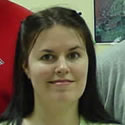 Dara Hooker has been the lab technician for the Boundary Layer Stress
and Sediment Transport (BLASST) laboratory since May of 2002. Dara
has two undergraduate degrees from the University of South Carolina-
a B.A. in International Studies and a B.S. in Marine Science. She
will start work on her M.S. in Marine Science at USC this fall. This
is her first research cruise on the open ocean. Dara will be gathering
data using the CTD (conductivity, temperature, depth) and the Acoustic
Doppler Current Profiler (ADCP). She will also be helping with the
creation and deployment of the clod cards. Dara is interested in the
dynamics of sediment transport, specifically as it relates to the
spread of pollutants. She is also interested in the effect of current
flow on the physiological characteristics of benthic invertebrates
which makes this the perfect cruise for her.
Dara Hooker has been the lab technician for the Boundary Layer Stress
and Sediment Transport (BLASST) laboratory since May of 2002. Dara
has two undergraduate degrees from the University of South Carolina-
a B.A. in International Studies and a B.S. in Marine Science. She
will start work on her M.S. in Marine Science at USC this fall. This
is her first research cruise on the open ocean. Dara will be gathering
data using the CTD (conductivity, temperature, depth) and the Acoustic
Doppler Current Profiler (ADCP). She will also be helping with the
creation and deployment of the clod cards. Dara is interested in the
dynamics of sediment transport, specifically as it relates to the
spread of pollutants. She is also interested in the effect of current
flow on the physiological characteristics of benthic invertebrates
which makes this the perfect cruise for her.
|
Connie
Leverett
Educator-at-Sea
Science Teacher Specialist
Burke High SchoolCharleston, South Carolina
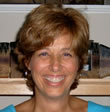 Connie
grew up along the Gulf Coast in Gulfport, Mississippi. Ever since
she found her first hermit crab, she has loved the ocean and all the
exciting critters that live in it! When scientists on the deep sea
submersible Alvin made the first discoveries of organisms in hydrothermal
vent communities, Connie and a couple of friends poured over the pictures
in National Geographic in complete amazement. And now she is getting
the opportunity to take part in an expedition using submersibles to
explore the Charleston Bump! Connie
grew up along the Gulf Coast in Gulfport, Mississippi. Ever since
she found her first hermit crab, she has loved the ocean and all the
exciting critters that live in it! When scientists on the deep sea
submersible Alvin made the first discoveries of organisms in hydrothermal
vent communities, Connie and a couple of friends poured over the pictures
in National Geographic in complete amazement. And now she is getting
the opportunity to take part in an expedition using submersibles to
explore the Charleston Bump!
Connie
graduated from the University of Southern Mississippi with a B.S.
in
Biology. Although Connie loved marine biology, teaching became herprofession
because she loves exploring patterns in the natural world with students.
Connie also has a Masters in Education from Southern. Connie's been
teaching school for nineteen years. Connie's jobs have included teaching
biology, physical science, marine camp at the J.L. Scott Marine Education
Center, and teaching teachers in Curriculum Leadership Institutes
when she worked at the Charleston Math & Science Hub as the Science
Specialist. Currently, Connie is the Science Teacher Specialist at
Burke High School. Go Bulldogs! She is also an Educational Leadership
Partner at the South Carolina Aquarium in Charleston. In all of her
teaching jobs, principles of marine biology and oceanography have
been woven into the curriculum and the distinctive adaptations of
hydrothermal vent organisms have always been a favorite topic. Connie
is looking forward to learning more about the organisms of the Charleston
Bump and the physical parameters of this area of the ocean on this
cruise!
|
Joshua
K. Loefer
Marine Biologist
Marine Resources Research Institute,
South Carolina Department of Natural Resources
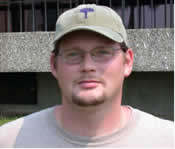 Josh
Loefer is a Marine Biologist with the South Carolina Department of
Natural Resources. He will assist with cruise logistics, data acquisition,
GIS analysis, and sample collection. Josh holds a BA in biology from
Furman University in 1996, and an MS in Marine Biology from the University
of Charleston (SC) in 2000. His main research interests: the life
history of sharks, snappers, and groupers; satellite telemetry tagging
of billfishes and sharks; and the hydrography of the Charleston Bump
complex. Josh
Loefer is a Marine Biologist with the South Carolina Department of
Natural Resources. He will assist with cruise logistics, data acquisition,
GIS analysis, and sample collection. Josh holds a BA in biology from
Furman University in 1996, and an MS in Marine Biology from the University
of Charleston (SC) in 2000. His main research interests: the life
history of sharks, snappers, and groupers; satellite telemetry tagging
of billfishes and sharks; and the hydrography of the Charleston Bump
complex.
|
Jerry
A. McLelland
Research Associate
Department of Coastal Sciences
University of Southern Mississippi
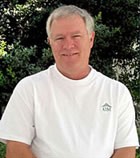 Jerry
McLelland, a native of Mississippi, has worked for 25 years as a marine
biologist at USM’s Gulf Coast Research Laboratory specializing
in invertebrate taxonomy, systematics and ecology with expertise both
in the planktonic and benthic environments. His background includes
investigations into coastal and marine habitats of the northern Gulf
of Mexico, Florida Keys, and several sites in the Caribbean Sea, including
the Cayman Islands, Turks and Caicos Islands, and Tobago. His publication
record includes new species descriptions of Polychaeta, Chaetognatha
and Cumacea. He is currently working on doctoral research on zoogeography
and systematics of deep-water Tanaidacea, micro-crustaceans similar
to isopods. Mr. McLelland will assist in collecting plankton and benthic
invertebrates and hopes to obtain tanaid specimens for his research Jerry
McLelland, a native of Mississippi, has worked for 25 years as a marine
biologist at USM’s Gulf Coast Research Laboratory specializing
in invertebrate taxonomy, systematics and ecology with expertise both
in the planktonic and benthic environments. His background includes
investigations into coastal and marine habitats of the northern Gulf
of Mexico, Florida Keys, and several sites in the Caribbean Sea, including
the Cayman Islands, Turks and Caicos Islands, and Tobago. His publication
record includes new species descriptions of Polychaeta, Chaetognatha
and Cumacea. He is currently working on doctoral research on zoogeography
and systematics of deep-water Tanaidacea, micro-crustaceans similar
to isopods. Mr. McLelland will assist in collecting plankton and benthic
invertebrates and hopes to obtain tanaid specimens for his research
|
Denise Strickland
Laboratory Technician
Marine Science Program, College of Education
University of South Carolina 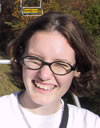 Denise
Strickland is a lab technician for Dr. Brian Helmuth, working on various
biophysics projects and education initiatives. She has an undergraduate
degree in Biology from the University of South Carolina, and hopes
to start graduate school next fall. Her previous research includes
work at the University of South Carolina and Savannah River Ecology
Laboratory involving American alligator population genetics and quantification
of mercury in alligator tissues. During the cruise, she will be working
on invertebrate taxonomy and education, two of her primary interests.
Her other interests include invertebrate reproductive strategies and
physiological adaptations of intertidal organisms. Denise
Strickland is a lab technician for Dr. Brian Helmuth, working on various
biophysics projects and education initiatives. She has an undergraduate
degree in Biology from the University of South Carolina, and hopes
to start graduate school next fall. Her previous research includes
work at the University of South Carolina and Savannah River Ecology
Laboratory involving American alligator population genetics and quantification
of mercury in alligator tissues. During the cruise, she will be working
on invertebrate taxonomy and education, two of her primary interests.
Her other interests include invertebrate reproductive strategies and
physiological adaptations of intertidal organisms.
|
Susan
Thornton-DeVictor
Southeastern Regional Taxonomic Center
South Carolina Department of Natural Resources
Charleston, SC
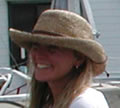 Susan
is a laboratory assistant at SERTC, where she has been responsible
for developing and maintaining a literature database for the taxonomic
reprint and book library. Susan also collects organisms for the curated
specimen collection from the South Atlantic Bight, often using SCUBA
to collect in deeper offshore areas or in estuaries. Susan has been
maintaining SERTC’s website (http://www.dnr.state.sc.us/marine/sertc)
which has recently been launched. Susan also assists with building
and maintaining our specimen image library, which utilizes my keen
interest in scientific and underwater photography. Susan
is a laboratory assistant at SERTC, where she has been responsible
for developing and maintaining a literature database for the taxonomic
reprint and book library. Susan also collects organisms for the curated
specimen collection from the South Atlantic Bight, often using SCUBA
to collect in deeper offshore areas or in estuaries. Susan has been
maintaining SERTC’s website (http://www.dnr.state.sc.us/marine/sertc)
which has recently been launched. Susan also assists with building
and maintaining our specimen image library, which utilizes my keen
interest in scientific and underwater photography.
Susan's
background includes a B.S. in Biological Sciences from SUNY Stony
Brook, several years of high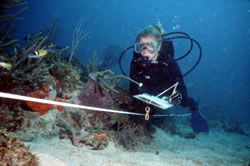 school teaching, and graduate school at Nova Southeastern University
Oceanographic Center. Her Masters work (completed in 2000) investigated
the growth rate of the Caribbean coral Porites astreoides, or Mustard
Hill coral. She spent several years doing assessment, monitoring and
restoration work on coral reefs in south Florida, Puerto Rico, and
various areas in the Caribbean. Her interest in coral growth and ecology
transcends to deeper water species, which are among the goals of this
year’s Ocean Explorer cruise. Susan hopes to gain valuable knowledge
as well as contribute to scientific and educational aspects of the
mission.
school teaching, and graduate school at Nova Southeastern University
Oceanographic Center. Her Masters work (completed in 2000) investigated
the growth rate of the Caribbean coral Porites astreoides, or Mustard
Hill coral. She spent several years doing assessment, monitoring and
restoration work on coral reefs in south Florida, Puerto Rico, and
various areas in the Caribbean. Her interest in coral growth and ecology
transcends to deeper water species, which are among the goals of this
year’s Ocean Explorer cruise. Susan hopes to gain valuable knowledge
as well as contribute to scientific and educational aspects of the
mission. |
Phil
Weinbach
GIS Manager
South Carolina Dept. of Natural Resources
 Phil Weinbach grew up in Columbia, South Carolina. He moved to Charleston
in
Phil Weinbach grew up in Columbia, South Carolina. He moved to Charleston
in 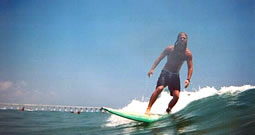 1992
to attend the College of Charleston. He earned a BS in Marine Biology
in 1996 followed by a Master’s Degree in Environmental Science
from the University of Charleston in 1998. His love for the ocean and
the outdoors has kept him in beautiful Charleston and has allowed him
to enjoy his favorite hobbies: fishing, surfing and boating. Phil began
working for the Marine Resources Division of the South Carolina Department
of Natural Resources in 1998 and is currently the GIS Manager. He is
actively involved in many projects for the DNR including the Charleston
Bump study. He has participated in several longlining cruises involving
satellite tagging swordfish and various shark species. While at sea
with the Ocean Exploration, Phil will use his GIS skills to help researchers
decide on dive sites and analyze data. 1992
to attend the College of Charleston. He earned a BS in Marine Biology
in 1996 followed by a Master’s Degree in Environmental Science
from the University of Charleston in 1998. His love for the ocean and
the outdoors has kept him in beautiful Charleston and has allowed him
to enjoy his favorite hobbies: fishing, surfing and boating. Phil began
working for the Marine Resources Division of the South Carolina Department
of Natural Resources in 1998 and is currently the GIS Manager. He is
actively involved in many projects for the DNR including the Charleston
Bump study. He has participated in several longlining cruises involving
satellite tagging swordfish and various shark species. While at sea
with the Ocean Exploration, Phil will use his GIS skills to help researchers
decide on dive sites and analyze data. |
David
M. Wyanski
Fish Biologist
Marine Resources Research Institute
South Carolina Dept. of Natural Resources
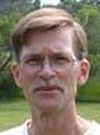 David
Wyanski is a fish biologist with the Marine Resources Monitoring Assessment
and David
Wyanski is a fish biologist with the Marine Resources Monitoring Assessment
and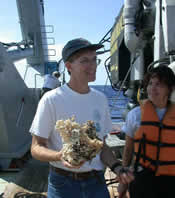 Prediction (MARMAP) Program, a cooperative fishery-independent monitoring
and research program that is based at SCDNR in Charleston, SC, and
supported by the National Marine Fisheries Service. He is a native
of the New England states and received a B.A. degree in Zoology from
the University of Maine. After working in Savannah, Georgia, as a
research technician for a fish ecologist and as a middle school science
teacher, he migrated to the Virginia Institute of Marine Science,
College of William and Mary, to complete an M.S. degree in Marine
Science. He presently oversees the studies of fish reproduction that
are part of the life history research being conducted by MARMAP and
participates in cruises to monitor the size and abundance of reef
fishes off the southeast coast of the U.S. His other research interests
are the taxonomy, growth, and movements of marine fish. During the
Charleston Bump mission, he will put his fish taxonomy skills to work
by examining rarely encountered species collected on sub dives and
by identifying fishes on videotape records from sub dives.
Prediction (MARMAP) Program, a cooperative fishery-independent monitoring
and research program that is based at SCDNR in Charleston, SC, and
supported by the National Marine Fisheries Service. He is a native
of the New England states and received a B.A. degree in Zoology from
the University of Maine. After working in Savannah, Georgia, as a
research technician for a fish ecologist and as a middle school science
teacher, he migrated to the Virginia Institute of Marine Science,
College of William and Mary, to complete an M.S. degree in Marine
Science. He presently oversees the studies of fish reproduction that
are part of the life history research being conducted by MARMAP and
participates in cruises to monitor the size and abundance of reef
fishes off the southeast coast of the U.S. His other research interests
are the taxonomy, growth, and movements of marine fish. During the
Charleston Bump mission, he will put his fish taxonomy skills to work
by examining rarely encountered species collected on sub dives and
by identifying fishes on videotape records from sub dives.
|


 George Sedberry is the Principal Investigator on the Ocean Exploration
2003 Expedition to the Charleston Bump. He spent his formative years
on the Chesapeake Bay in Virginia, where he completed a B.S. degree
in Biology at Old Dominion University, and the M.S. and Ph.D. degrees
in Marine Science at the Virginia Institute of Marine Science, College
of William and Mary. He is a Senior Marine Scientist at the Marine Resources
Research Institute, South Carolina Department of Natural Resources.
He is Assistant Director of MRRI where he has worked since 1980. His
interests and experience are in the biology, conservation and management
of reef fishes and highly migratory oceanic fishes, as well as deep-sea
biology and coral-reef
George Sedberry is the Principal Investigator on the Ocean Exploration
2003 Expedition to the Charleston Bump. He spent his formative years
on the Chesapeake Bay in Virginia, where he completed a B.S. degree
in Biology at Old Dominion University, and the M.S. and Ph.D. degrees
in Marine Science at the Virginia Institute of Marine Science, College
of William and Mary. He is a Senior Marine Scientist at the Marine Resources
Research Institute, South Carolina Department of Natural Resources.
He is Assistant Director of MRRI where he has worked since 1980. His
interests and experience are in the biology, conservation and management
of reef fishes and highly migratory oceanic fishes, as well as deep-sea
biology and coral-reef  ecology.
Most of his research is concentrated on hard bottom reefs of subtropical
and temperate waters off the southeastern U.S., but he has conducted
research on Marine Protected Areas in Belize and on population biology
of fishes from the North and South Atlantic, Caribbean Sea, Mediterranean
Sea and the western South Pacific. He serves on the Marine Protected
Areas Advisory Panel and the Snapper/Grouper Assessment Panel of the
South Atlantic Fishery Management Council; is Vice Chairman of the Gray’s
Reef National Marine Sanctuary Advisory Council; and is on the boards
of the Southeast Center for Ocean Science Education Excellence and the
South Carolina Marine Educators Association. He is also an Adjunct Professor
at the College of Charleston, where he advises graduate students and
teaches marine fisheries science. He is a member of the American Fisheries
Society, the American Society of Ichthyologists and Herpetologists and
a fellow of the American Institute of Fishery Research Biologists. He
has authored over 70 scientific publications on marine fishes and ecosystems.
ecology.
Most of his research is concentrated on hard bottom reefs of subtropical
and temperate waters off the southeastern U.S., but he has conducted
research on Marine Protected Areas in Belize and on population biology
of fishes from the North and South Atlantic, Caribbean Sea, Mediterranean
Sea and the western South Pacific. He serves on the Marine Protected
Areas Advisory Panel and the Snapper/Grouper Assessment Panel of the
South Atlantic Fishery Management Council; is Vice Chairman of the Gray’s
Reef National Marine Sanctuary Advisory Council; and is on the boards
of the Southeast Center for Ocean Science Education Excellence and the
South Carolina Marine Educators Association. He is also an Adjunct Professor
at the College of Charleston, where he advises graduate students and
teaches marine fisheries science. He is a member of the American Fisheries
Society, the American Society of Ichthyologists and Herpetologists and
a fellow of the American Institute of Fishery Research Biologists. He
has authored over 70 scientific publications on marine fishes and ecosystems. Dr. Helmuth is a marine physiological ecologist with a focus on benthic
invertebrates. He and his students use engineering methods (biophysics
and biomechanics) to study the ways in which animals interact with their
environment. Much of his most recent research has centered on the effects
Dr. Helmuth is a marine physiological ecologist with a focus on benthic
invertebrates. He and his students use engineering methods (biophysics
and biomechanics) to study the ways in which animals interact with their
environment. Much of his most recent research has centered on the effects
 of
climate change on intertidal animals in the eastern Pacific, and he
and his colleagues have developed methods for predicting the temperatures
of animals from climatic data. Dr. Helmuth also has extensive experience
working on coral reefs, and he has active projects in Belize and Florida,
including several saturation missions in the Aquarius habitat. Dr. Helmuth
is a principal investigator for the Invertebrate Diversity project on
this cruise, and will work with other team members to link aspects of
small-scale water flow to patterns in invertebrate diversity. He also
has a deep interest in developing collaborations between higher education
faculty and K-12 students and teachers, and is an active member of the
South Carolina Marine Educator’s Association. which can be found
at http://www.coastal.edu/science/scmea/
of
climate change on intertidal animals in the eastern Pacific, and he
and his colleagues have developed methods for predicting the temperatures
of animals from climatic data. Dr. Helmuth also has extensive experience
working on coral reefs, and he has active projects in Belize and Florida,
including several saturation missions in the Aquarius habitat. Dr. Helmuth
is a principal investigator for the Invertebrate Diversity project on
this cruise, and will work with other team members to link aspects of
small-scale water flow to patterns in invertebrate diversity. He also
has a deep interest in developing collaborations between higher education
faculty and K-12 students and teachers, and is an active member of the
South Carolina Marine Educator’s Association. which can be found
at http://www.coastal.edu/science/scmea/ Dr.
Wenner grew up on Chesapeake Bay where she developed an early love for
the sea and its inhabitants. After receiving a BS degree in Biology
from Mary Washington College, she attended graduate school at the Virginia
Institute of Marine Science of the College of William and Mary where
she received MS and Ph.D. degrees in Marine Science. Her dissertation
research described communities of decapod crustaceans along a depth
gradient from the upper to lower continental slope in the Norfolk Canyon.
She has worked for the last twenty-two years as a research marine scientist
and program manager for Crustacean and Wetlands Research at the Marine
Resources Center of the South Carolina Department of Natural Resources,
located in Charleston, SC. During her tenure at the Marine Resources
Center, she has studied invertebrate communities in a variety of habitats
from estuaries to the deepsea. Her special interest is the decapod crustaceans
or crabs and shrimps. Dr. Wenner also heads up the Southeastern Regional
Taxonomic Center, housed within SCDNR’s Marine Resources Research
Institute (MRRI). The SERTC provides a regional focus on developing
taxonomic expertise and skills, as well as the infrastructure needed
to support the natural resource management and scientific communities
within the South Atlantic Bight. The Center is staffed by SCDNR employees
with a background in taxonomy and serves as a clearinghouse, training
facility, specimen repository, and a venue for a
Dr.
Wenner grew up on Chesapeake Bay where she developed an early love for
the sea and its inhabitants. After receiving a BS degree in Biology
from Mary Washington College, she attended graduate school at the Virginia
Institute of Marine Science of the College of William and Mary where
she received MS and Ph.D. degrees in Marine Science. Her dissertation
research described communities of decapod crustaceans along a depth
gradient from the upper to lower continental slope in the Norfolk Canyon.
She has worked for the last twenty-two years as a research marine scientist
and program manager for Crustacean and Wetlands Research at the Marine
Resources Center of the South Carolina Department of Natural Resources,
located in Charleston, SC. During her tenure at the Marine Resources
Center, she has studied invertebrate communities in a variety of habitats
from estuaries to the deepsea. Her special interest is the decapod crustaceans
or crabs and shrimps. Dr. Wenner also heads up the Southeastern Regional
Taxonomic Center, housed within SCDNR’s Marine Resources Research
Institute (MRRI). The SERTC provides a regional focus on developing
taxonomic expertise and skills, as well as the infrastructure needed
to support the natural resource management and scientific communities
within the South Atlantic Bight. The Center is staffed by SCDNR employees
with a background in taxonomy and serves as a clearinghouse, training
facility, specimen repository, and a venue for a  taxonomic
library. Dr. Wenner works on numerous other projects at MRRI, and is
principal investigator for the SEAMAP Shallow Water Trawl Program, serves
as Research Coordinator for the ACE Basin National Estuarine Research
Reserve (NERR), and supervises the state’s crustacean monitoring
program for blue crab and commercially important shrimp. She has been
elected to numerous offices, including President of The Crustacean Society,
an international scientific organization. Over the years, she has been
appointed to serve on several national advisory and technical committees,
including an appointment by the Secretary of Commerce to the Marine
Fisheries Advisory Committee of the National Marine Fisheries Service.
She has written over 80 scientific publications and in her spare time,
enjoys showing her Labrador retrievers, running, gardening and antique
collecting. She and her husband, Dr. Charles Wenner, live on beautiful
Wadmalaw Island, a rural sea island located south of Charleston.
taxonomic
library. Dr. Wenner works on numerous other projects at MRRI, and is
principal investigator for the SEAMAP Shallow Water Trawl Program, serves
as Research Coordinator for the ACE Basin National Estuarine Research
Reserve (NERR), and supervises the state’s crustacean monitoring
program for blue crab and commercially important shrimp. She has been
elected to numerous offices, including President of The Crustacean Society,
an international scientific organization. Over the years, she has been
appointed to serve on several national advisory and technical committees,
including an appointment by the Secretary of Commerce to the Marine
Fisheries Advisory Committee of the National Marine Fisheries Service.
She has written over 80 scientific publications and in her spare time,
enjoys showing her Labrador retrievers, running, gardening and antique
collecting. She and her husband, Dr. Charles Wenner, live on beautiful
Wadmalaw Island, a rural sea island located south of Charleston.  Jeremy
Potter grew up in wild wonderful West Virginia and graduated from Davidson
College in North Carolina. Immediately after college, he became nervous
about beginning law school and ran off to Alaska to work as an observer
in the Bering Sea crab fishery, and later as an instructor at the Wallops
Island Marine Science Consortium. In 1997, he again ran from graduate
school to spend one year teaching English in rural Japan. Three years
later, he returned to the US to pursue his interests in international
environmental politics, facilitation, and negotiation. Mr. Potter is
a master’s student at the Duke University School of the Environment.
His current research in international fisheries policy focuses on the
Japanese pelagic longline industry. His fascination with the deep sea
led him to NOAA’s Office of Ocean Exploration (OE) where he is
a Dean John A. Knauss Marine Policy Sea Grant Fellow. In the office,
he spends most of his time integrating the operations and science programs.
Jeremy
Potter grew up in wild wonderful West Virginia and graduated from Davidson
College in North Carolina. Immediately after college, he became nervous
about beginning law school and ran off to Alaska to work as an observer
in the Bering Sea crab fishery, and later as an instructor at the Wallops
Island Marine Science Consortium. In 1997, he again ran from graduate
school to spend one year teaching English in rural Japan. Three years
later, he returned to the US to pursue his interests in international
environmental politics, facilitation, and negotiation. Mr. Potter is
a master’s student at the Duke University School of the Environment.
His current research in international fisheries policy focuses on the
Japanese pelagic longline industry. His fascination with the deep sea
led him to NOAA’s Office of Ocean Exploration (OE) where he is
a Dean John A. Knauss Marine Policy Sea Grant Fellow. In the office,
he spends most of his time integrating the operations and science programs. A
love of the Ocean is what brought Dewey to where heam today. Dewey received
A B.S. in Marine Biology from The College of Charleston in South Carolina
in 1998. Dewey moved to Palm Beach Florida after graduation, scuba diving
constantly working as a Dive
A
love of the Ocean is what brought Dewey to where heam today. Dewey received
A B.S. in Marine Biology from The College of Charleston in South Carolina
in 1998. Dewey moved to Palm Beach Florida after graduation, scuba diving
constantly working as a Dive  Master
aboard a few of the locally operated dive boats here he learned first
hand reef habitats and their species interactions. Dewey also worked
at the Marinelife Center of Juno Beach working as a Sea Turtle Biologist.
The center was a Turtle rehabilitation clinic as well as conducting
nesting surveys on five miles of very heavily nested beach. In the years
after Florida Dewey spent time with a internet start-up in Boston learning
technologies. The lure of the ocean called again and Dewey went to sea
as a deckhand on 300+ ton motor yachts. Not much science, but the chance
to sea many diverse ocean habitats from the large, cold water species
of the Pacific NorthWest to the over fished Mediterranean. When he was
recently offered the chance to return to the College of Charleston and
marine sciences he jumped at it. Now Dewey works up the education outreach
websites that accompany Scientific exploration and research in the SouthEast
region. During the Charleston Bump mission Dewey will be build up the
website you are now on, create educational resources and compile photo
and video galleries.
Master
aboard a few of the locally operated dive boats here he learned first
hand reef habitats and their species interactions. Dewey also worked
at the Marinelife Center of Juno Beach working as a Sea Turtle Biologist.
The center was a Turtle rehabilitation clinic as well as conducting
nesting surveys on five miles of very heavily nested beach. In the years
after Florida Dewey spent time with a internet start-up in Boston learning
technologies. The lure of the ocean called again and Dewey went to sea
as a deckhand on 300+ ton motor yachts. Not much science, but the chance
to sea many diverse ocean habitats from the large, cold water species
of the Pacific NorthWest to the over fished Mediterranean. When he was
recently offered the chance to return to the College of Charleston and
marine sciences he jumped at it. Now Dewey works up the education outreach
websites that accompany Scientific exploration and research in the SouthEast
region. During the Charleston Bump mission Dewey will be build up the
website you are now on, create educational resources and compile photo
and video galleries.

 Phil Weinbach grew up in Columbia, South Carolina. He moved to Charleston
in
Phil Weinbach grew up in Columbia, South Carolina. He moved to Charleston
in  1992
to attend the College of Charleston. He earned a BS in Marine Biology
in 1996 followed by a Master’s Degree in Environmental Science
from the University of Charleston in 1998. His love for the ocean and
the outdoors has kept him in beautiful Charleston and has allowed him
to enjoy his favorite hobbies: fishing, surfing and boating. Phil began
working for the Marine Resources Division of the South Carolina Department
of Natural Resources in 1998 and is currently the GIS Manager. He is
actively involved in many projects for the DNR including the Charleston
Bump study. He has participated in several longlining cruises involving
satellite tagging swordfish and various shark species. While at sea
with the Ocean Exploration, Phil will use his GIS skills to help researchers
decide on dive sites and analyze data.
1992
to attend the College of Charleston. He earned a BS in Marine Biology
in 1996 followed by a Master’s Degree in Environmental Science
from the University of Charleston in 1998. His love for the ocean and
the outdoors has kept him in beautiful Charleston and has allowed him
to enjoy his favorite hobbies: fishing, surfing and boating. Phil began
working for the Marine Resources Division of the South Carolina Department
of Natural Resources in 1998 and is currently the GIS Manager. He is
actively involved in many projects for the DNR including the Charleston
Bump study. He has participated in several longlining cruises involving
satellite tagging swordfish and various shark species. While at sea
with the Ocean Exploration, Phil will use his GIS skills to help researchers
decide on dive sites and analyze data.